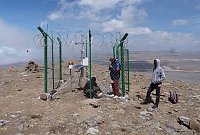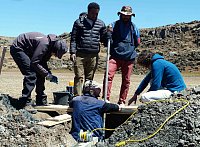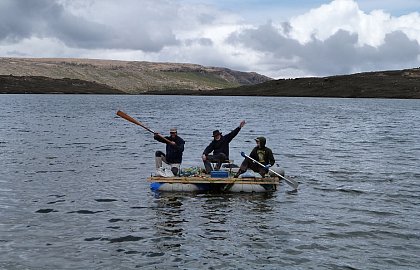FOR 2358: Paleoclimatology
Mountain Exile Hypothesis: How humans benefited from and re-shaped African high altitude ecosystems during Quarternary climatic changes
From 2016
- Project sponsor: DFG - German Research Foundation
- Project leader: Dr. Michael Zech
- Collaborator: Bruk Lemma
Subproject: Palaeoclimatology – Stable oxygen (18O/16O) and hydrogen (2H/1H) isotope signatures of plants, soils and precipitation along elevation transects, and from palaeoclimate archives in the Bale Mountains

lake Garba Guracha (photo: Michael Zech)
Ethiopia receives most of its rainfall from winds from the south brought by the East African summer monsoon during the northern hemisphere summer months. However, the intensity of East African monsoon rainfall varied considerably during the Quaternary period, and the proportion of rainfall brought by westerlies may also have been highly variable in the past. In recent years, a number of new biomarker and stable isotope methods have been developed that are highly innovative and promising (semi-)quantitative paleoclimate proxies. Through the development and application of such biomarker and stable isotope methods, the proposed project aims to contribute to the (semi-)quantitative paleoclimate reconstruction of the Bale Mountains in Ethiopia. In particular, temperature, relative humidity, precipitation and changes in the source area of precipitation will be reconstructed.

Climate station (photo: Marianne Benesch)
As part of one of the work packages, recent precipitation will be examined in terms of its isotopic signature (2H/1H and 18O/16O) in terms of both space and time. Among other things, these data should help to better understand the atmospheric circulation systems relevant to the Bale Mountains and their specific isotopic signatures.
A second work package will investigate how accurately the isotopic signature of precipitation, relative humidity and temperature are reflected in the biomarker and stable isotope signatures of plants and soils. To this end, climate gradients along altitude transects in the Bale Mountains will be investigated. The methodological focus will be on the investigation of component-specific 2H analyses of plant wax-derived n-alkane and fatty acid biomarkers, component-specific 18O analyses of hemicellulose-derived sugar biomarkers, and soil bacteria-derived glycerol dialkyl glycerol tetraether (GDGT) lipid biomarkers.

Drilling (photo: Marianne Benesch)
The third work package contributes to the extraction of sediment cores and the establishment of associated chronostratigraphies. These sediment cores will be used together with subprojects P2-Antrosole and P4-Palaeoecology as archives to reconstruct the history of human settlement as well as the Late Quaternary climate and landscape history of the Bale Mountains. Subproject P5-Palaeoclimatology will use the biomarker and stable isotope methods specified above for this purpose.

Sediment core (photo: Michael Zech)

Homemade drilling platform (photo: Marianne Benesch)
- Press article:www.magazin.uni-halle.de




